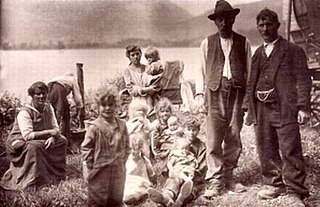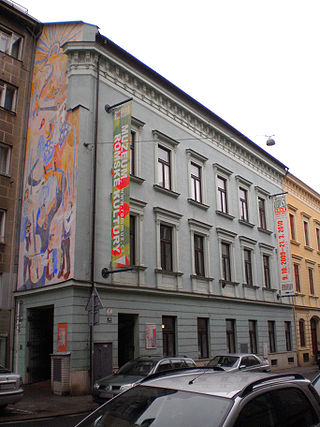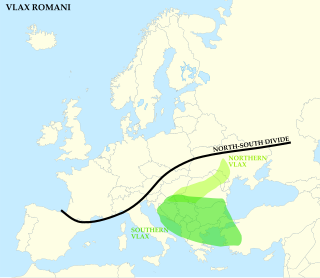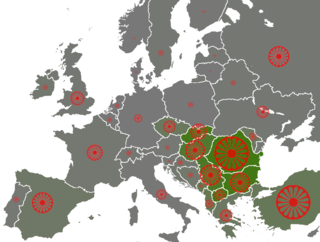
The Romani, also spelled Romany or Rromani, colloquially known as the Roma, are an Indo-Aryan ethnic group who traditionally lived a nomadic, itinerant lifestyle. Linguistic and genetic evidence suggests that the Romani originated in the Indian subcontinent; in particular, the region of present-day Rajasthan. Their subsequent westward migration, possibly in waves, is now believed by historians to have occurred around 1000 CE. Their original name is from the Sanskrit word डोम (doma) and means a member of a Dalit caste of travelling musicians and dancers. The Roma population moved west into the Persian Ghaznavid Empire and later into the Byzantine Empire. The Roma arrived in Europe around the 13th to 14th century. Although they are dispersed, their most concentrated populations are located in Europe, especially central, eastern, and southern Europe, as well as western Asia.
Romani is an Indo-Aryan macrolanguage of the Romani communities. According to Ethnologue, seven varieties of Romani are divergent enough to be considered languages of their own. The largest of these are Vlax Romani, Balkan Romani (600,000), and Sinte Romani (300,000). Some Romani communities speak mixed languages based on the surrounding language with retained Romani-derived vocabulary – these are known by linguists as Para-Romani varieties, rather than dialects of the Romani language itself.

The Romani Holocaust or the Romani genocide—also known as the Porajmos, the Pharrajimos, and the Samudaripen —was the planned effort by Nazi Germany and its World War II allies and collaborators to commit ethnic cleansing and eventually genocide against European Roma and Sinti peoples during the Holocaust era.

The Sinti are a subgroup of Romani people, found mostly in Germany and Central Europe, numbering some 200,000 people. They were traditionally itinerant, but today only a small percentage of Sinti remain unsettled. In earlier times, they frequently lived on the outskirts of communities.
The Romani people have long been a part of the collective mythology of the West, where they were depicted as outsiders, aliens, and a threat. For centuries they were enslaved in Eastern Europe and hunted in Western Europe: the Pořajmos, Hitler's attempt at genocide, was one violent link in a chain of persecution that encompassed countries generally considered more tolerant of minorities, such as the United Kingdom. Even today, while there is a surge of Romani self-identification and pride, restrictive measures are being debated and passed by democratic states to curb the rights of the Romani people.

The Yenish are an itinerant group in Western Europe who live mostly in Germany, Austria, Switzerland, Luxembourg, Belgium, and parts of France, roughly centred on the Rhineland. A number of theories for the group's origins have been proposed, including that the Yenish descended from members of the marginalized and vagrant poor classes of society of the early modern period, before emerging as a distinct group by the early 19th century. Most of the Yenish became sedentary in the course of the mid-19th to 20th centuries.

The Museum of Romani Culture is an institution dedicated to the history and culture of the Romani people (Gypsies). It is situated in Brno, Czech Republic.

Vlax Romani is a dialect group of the Romani language. Vlax Romani varieties are spoken mainly in Southeastern Europe by the Romani people. Vlax Romani can also be referred to as an independent language or as one dialect of the Romani language. Vlax Romani is the second most widely spoken dialect subgroup of the Romani language worldwide, after Balkan Romani.
The Romani people, also referred to as Roma, Sinti or Kale, depending on the sub-group, are an Indo-Aryan ethnic group which primarily lives in Europe. The Romani may have migrated from what is the modern Indian state of Rajasthan, migrating to the northwest around 250 BCE. Their subsequent westward migration, possibly in waves, is now believed to have occurred beginning in about 500 CE. It has also been suggested that emigration from India may have taken place in the context of the raids by Mahmud of Ghazni. As these soldiers were defeated, they were moved west with their families into the Byzantine Empire. The author Ralph Lilley Turner theorised a central Indian origin of Romani followed by a migration to Northwest India as it shares a number of ancient isoglosses with Central Indo-Aryan languages in relation to realization of some sounds of Old Indo-Aryan. This is lent further credence by its sharing exactly the same pattern of northwestern languages such as Kashmiri and Shina through the adoption of oblique enclitic pronouns as person markers. The overall morphology suggests that Romani participated in some of the significant developments leading toward the emergence of New Indo-Aryan languages, thus indicating that the proto-Romani did not leave the Indian subcontinent until late in the second half of the first millennium.

Anti-Romani sentiment is a form of bigotry which consists of hostility, prejudice, discrimination, racism and xenophobia which is specifically directed at Romani people. Non-Romani itinerant groups in Europe such as the Yenish, Irish and Highland Travellers are frequently given the name "gypsy" and as a result, they are frequently confused with the Romani people. As a result, sentiments which were originally directed at the Romani people are also directed at other traveler groups and they are frequently referred to as "antigypsy" sentiments.

Romani people are an ethnic minority in the Czech Republic, currently making up 2–3% of the population. Originally migrants from North Western India sometime between the 6th and 11th centuries, they have long had a presence in the region. Since the creation of Czechoslovakia in 1918, the Romani population have experienced considerable hardship, having been a main target of Nazi extermination programs during World War II, and the subject of forced relocation, sterilisation, and other radical social policies during the Communist era. In the successor state, the Czech Republic, challenges remain for the Romani population with respect to education and poverty, and there are frequent tensions with the white majority population over issues including crime and integration.

The Romani people have several distinct populations, the largest being the Roma and the Calé, who reached Anatolia and the Balkans in the early 12th century, from a migration out of the Indian subcontinent beginning about 1st century – 2nd century AD. They settled in the areas of present-day Turkey, Greece, Serbia, Romania, Croatia, Moldova, Bulgaria, North Macedonia, Hungary, Albania, Kosovo, Bosnia and Herzegovina, Czech Republic, Slovenia and Slovakia, by order of volume, and Spain. From the Balkans, they migrated throughout Europe and, in the nineteenth and later centuries, to the Americas. The Roma population in the United States is estimated at more than one million.
Romani people in France, generally known in spoken French as gitans, tsiganes or manouches, are an ethnic group that originated in Northern India. The exact number of Romani people in France is unknown; estimates vary from 500,000 to 1,200,000.

The Romani people are also known by a variety of other names; in English as gypsies or gipsies, and Roma; in Greek as γύφτοι (gíftoi) or τσιγγάνοι (tsiggánoi), in Central and Eastern Europe as Tsingani ; in France as gitans besides the dated terms bohémiens and manouches; in Italy as rom and sinti besides the dated terms zingari, sigani, and gitani; in Spain as gitanos; and in Portugal as ciganos.
Sinte Romani is the variety of Romani spoken by the Sinti people in Germany, France, Austria, Belgium, the Netherlands, some parts of Northern Italy and other adjacent regions. Sinte Romani is characterized by significant German influence and is not mutually intelligible with other forms of Romani. The language is written in the Latin script.
Lovari is a subgroup of the Romani people, who speak their own dialect, influenced by Hungarian and West Slavic dialects. They live predominantly throughout Central Europe as well as in Southeastern Europe.

Carpathian Romani, also known as Central Romani or Romungro Romani, is a group of dialects of the Romani language spoken from southern Poland to Hungary, and from eastern Austria to Ukraine.
It is estimated that there are one million Romani people in the United States. Though the Romani population in the United States has largely assimilated into American society, the largest concentrations are in Southern California, the Pacific Northwest, Southwestern United States, Texas, Louisiana, Florida and the Northeast as well as in cities such as Chicago and St. Louis.

The Romani are an ethnic group that has lived in Austria since the Middle Ages. According to the 2001 census, there were 6,273 Romani speakers in Austria, or less than 0.1% of the population. Estimations count between 10,000 and 25,000. A more recent estimation count between 40,000 and 50,000 Romani people or about 0.5%. Most indigenous Romani people in Austria belong to the Burgenland-Roma group in East-Austria. The majority live in the state of Burgenland, in the city of Oberwart and in villages next to the District of Oberwart. The Burgenland-Roma speak the Vlax Romani language.

Romani people in Germany are estimated to around 170,000-300,000, constituting around 0.2-0.4% of the population. One-third of Germany Romani belong to the Sinti group. Most speak German or Sinte Romani.












